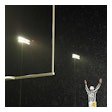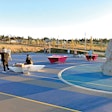![[Left photo courtesy of Matéflex, Right photo courtesy of Washington Capitals]](https://img.athleticbusiness.com/files/base/abmedia/all/image/2020/04/ab.startinglines420_feat.png?auto=format%2Ccompress&q=70&w=400)
In communities surrounding metro Washington, D.C., street hockey is experiencing a resurgence thanks to the Washington Capitals' efforts to build or refurbish street hockey rinks and provide hockey programs to area youths.
The National Hockey League's latest collective bargaining agreement with its Players' Association created the Industry Growth Fund, which focuses on growing the game by providing access to hockey in areas that may not have deep hockey roots.
"It's not necessarily focused on growing in Toronto, Chicago, Boston, New York," says Peter Robinson, director of youth hockey development with the Capitals. "It's more like your Nashville, Arizona, Columbus, Florida. But all teams have the ability to apply for grants from this fund, and the funds have to be used specifically for growing the game."
With a particular focus on providing what Robinson calls on-ramps for youths to get into the game, the Capitals applied for a grant that would refurbish existing street hockey rinks and build new ones that would offer youths in areas like Maryland, Virginia, West Virginia and the District of Columbia a safe place to give the sport a try.
From programs to facilities
The Capitals began promoting the game to area kids in 2007, when the team created its Hockey School Program.
"Essentially, we would bring two players and one of our coaches, and we would do about 16 schools a season," Robinson says. "It was mostly a PR event, it got a lot of attention from local media and news outlets would come, and it was great to see Ovi [Alexander Ovechkin] and Mike Green running around playing street hockey in front of 300 screaming kids."
Each assembly would end with the team donating the hockey equipment it had brought for the school to use in P.E. class, and Robinson helped teachers learn drills and develop curriculums around street hockey.
Once the funding became available, the team was able to replicate those successes across entire school districts.
"We're in the process of going to every county in our market," Robinson says. "We're partnering with the public school system and we're donating equipment to the elementary schools and the middle schools in that county. So, they're getting equipment for their school, they're getting training from our staff to their teachers on how to play and teach the sport, and then they're also going to be receiving a custom curriculum that we wrote that hits all of the educational standards that they're required to teach to in their county, in their state."
As a result, kids across Capitals country are trying out hockey for the first time, but the challenge changes at that point. How do you keep a new hockey player interested and engaged?
"Are they really going to trek 30 to 45 minutes to their closest ice rink and then sign up for learn-to-play or learn-to-skate, and then realize that skating's really hard and it hurts when you fall? Or does it make more sense for them to go to their local outdoor street hockey rink that belongs to the parks and rec department?" asks Robinson. "They can play in their sneakers, and use a stick and a ball that they're familiar with, because that's what they learned with in school. That was our thought process."
In all, 11 rinks have been completed, and five more are in the works. By the time the grant runs out, Robinson expects to have completed between 18 and 20 rinks, and to have brought access to the sport — whether through school programs or street hockey facilities — to hundreds of thousands of kids.
Each facility is equipped with a dasher board system, a playing surface, a branded scoreboard and goals.
"I first got involved when Peter reached out to us to help refurbish two rinks in West Virginia that had our surface down for about 10 years," says John Gleason, general manager with Matéflex. "After seeing how well our surface had held up for this project, they decided to use our tiles on other projects that they were working on."
Community partnerships
According to Robinson, each rink project represents a partnership with the municipality. After negotiating prices with product manufacturers and paying for installation, the Capitals essentially donate the freshly spruced-up rinks to the municipalities.
In return, the municipalities grant the Capitals exclusive branding rights and the ability to use the rink for their own programs.
"We want to try and go back and do free clinics, learn-to-play sessions, stuff like that," Robinson says. "We've done a few clinics at these rinks that are already completed, and if you sign up through our website and show up, we'll provide the stick, we'll provide a ball, we'll provide the instruction — and at the end of the clinic you get to keep the stick that you used and take a ball."
Netting a few early wins — by refurbishing a rink in D.C. after the city hosted the 2015 NHL Winter Classic, as well as a couple of others in Maryland and Virginia — helped the Capitals attract more municipal partners for their rink facilities.
"The outreach to all these different communities and different municipalities didn't always get a reaction or an answer," Robinson says, "But eventually it got to the point where they were reaching out to us instead of us trying to get their attention."
Impact
By being proactive and spurring interest in the sport at the grassroots level, the Capitals were well positioned to welcome a new generation of excited fans after the team won the Stanley Cup in 2018. Says Robinson, "The reception that we've had from the community and the excitement for the sport of hockey has been more than we expected."
Obviously, the Capitals have an interest in ensuring the continued success of hockey as a sport, but the impact goes well beyond that. Robinson likens the introduction of hockey in P.E. classes to academic lessons.
"It's just like reading or math or geometry or geography or history. Some kids love some subjects and they don't like others. But they learn to love learning because of the subject that they love. And we are trying to do the same thing, but for physical activity," he says. "It's just all part of a bigger initiative to just have healthier, more active youths."
Between programming and facilities, Robinson says the Capitals have brought hockey to some 725 schools and 600,000 students in their area.
For Robinson, a lifelong hockey fan who grew up in Maryland, being able to make an impact on his community has been a unique experience.
"If a kid has a love for the sport, and is watching us, and loves to see Ovi score goals and wants to try that for themselves, I don't want them to go 'Oh, I can't do that, that's not for me,' " he says. "That's not fair. We want to be able to make it accessible to everyone. So to be able to impact the community that I'm a part of, that I grew up in and that I continue to live in, is really special."
This article originally appeared in the April 2020 issue of Athletic Business with the title "Communities benefit from Washington Capitals investment in youth hockey." Athletic Business is a free magazine for professionals in the athletic, fitness and recreation industry. Click here to subscribe.

































